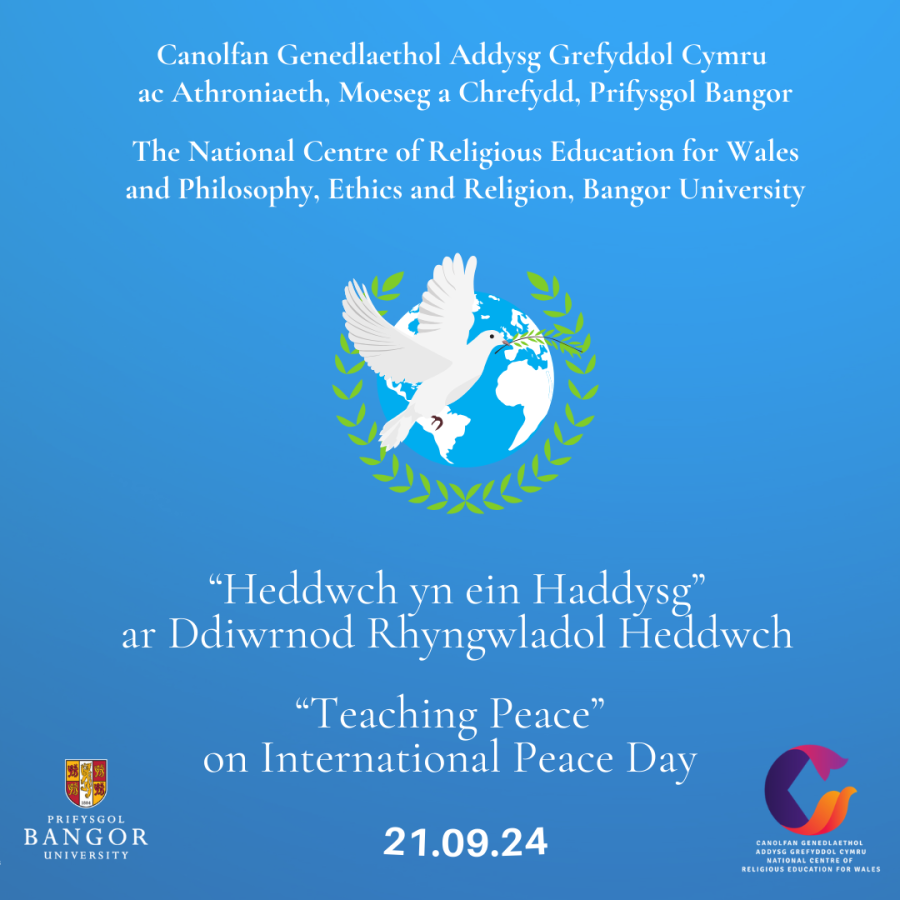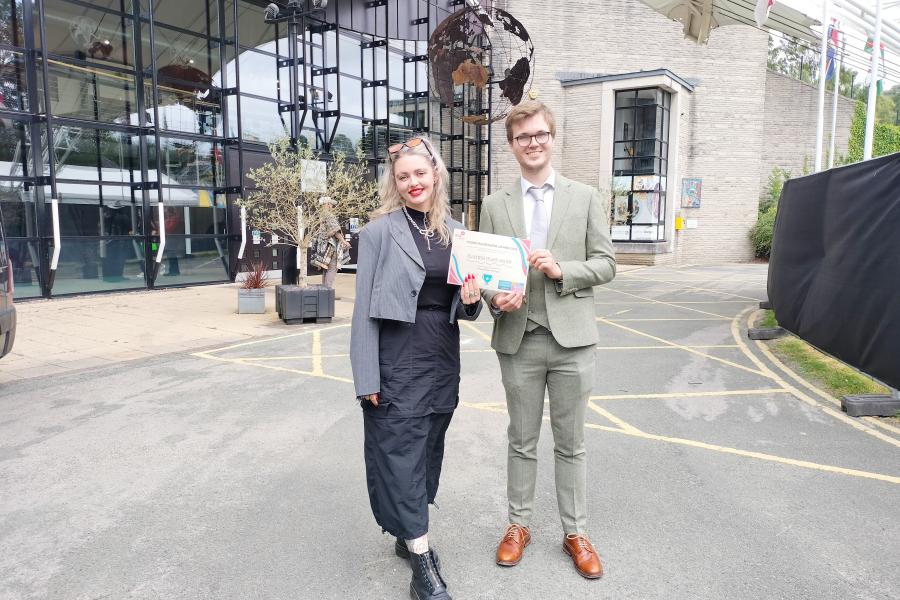
NCREW and Teaching Peace
In March this year, NCREW launched a collaborative project in which current students of Philosophy, Ethics and Religion, Bangor University, have been working with NCREW's directors and experienced teachers of Religion, Values and Ethics and Religious Education, to create education resources for Progression Step 4 (Key Stage 3) learners: Teaching Peace. These resources are intended to stimulate discussion and inspire learners to reflect on their own society, communities and lives, by learning about wider contexts. What is peace? How do we see peace in our times? In addition to wars and similar conflicts, what else is a threat to peace?
And in July 2024, Bangor University's undergraduate and doctoral students of Philosophy, Ethics and Religion, who have been working on the Teaching Peace project received a great honour from the Peace Academy of Wales and the Welsh Centre for International Affairs, when they were presented with the 'Peace Heritage Award' at the Llangollen International Eisteddfod. The Young Peoples Peace Awards are awarded annually to celebrate young people's work and passion in their aims for a more peaceful world and society, so it was special to see the young people involved in this project recognised for their efforts.
Dr Gareth Evans-Jones, one of NCREW’s directors and the co-ordinator for Teaching Peace, said: "We were so pleased to see the group receiving national recognition for all their hard work. I've been amazed at their passion and drive, and have thoroughly enjoyed the process of working with each and every one of the group to develop resources for a topic of such importance to all.”
With today being the United Nations Peace Day, it is appropriate to reflect on these resources, and hear the views of the people who have been part of Teaching Peace. As such, we are pleased to publish two statements by current Philosophy, Ethics and Religion students at Bangor University.
Gemma Waite (BA Philosophy, Ethics and Religion)

Hi, my name is Gemma, and I’m currently studying Philosophy, Ethics and Religion at Bangor University with the aim of completing a PGCE afterwards to be an RE teacher in a secondary school. I have also been working with the National Centre of Religious Education for Wales on the Teaching Peace project to create resources for PS4 (KS3) learners to engage more so with the matter of peace. We have been working on resources that explore different aspects of peace, including religious aspects, definitions regarding different forms of peace and conflict, and how to respond to them. Personally, I have been working on creating resources on the relationship between Judaism and peace and conflict, in addition to a case study for learners on Malala Yousafzai and her contribution to peace.
The hope with these resources is to ensure that learners have a better understanding of peace, and to recognise that peace and conflict do not exist only within the context of war. It is also an opportunity to learn in a variety of creative ways, whether in written forms, working within groups, or other ways that are perhaps less formal than normal lessons. Many learners will have experienced some form of conflict in their lives (be it bullying, disagreeing with friends or their family), and will subsequently seek peace – and learners will get to explore peace and conflict that way, instead of just through the context of war (although that is still important).
I'm working with NCREW on this project to gain experience of creating resources for learners from listening to what appeals to them, and on a topic that is also very important to me. Also, working with NCREW has been an invaluable experience to have, and will be a significant addition to my CV when applying for a PGCE course. I am hoping to continue working with NCREW on various other projects in the future to ensure that learners develop their education of various topics, with peace being central to many.
Richard Scott (PhD Religious Studies)
Hello, my name is Richard, a PhD researcher in the field of Religious Studies, and I am currently working with the National Centre of Religious Education for Wales (NCREW) on their Teaching Peace project, which aims to create resources and lessons for PS4 (KS3) learners on the current issues surrounding peace and conflict. Peace is a concept that is strived for by all the major world religions, yet, often, is not put into action, and we are surrounded by a world that cannot seemingly get to grips with a peaceful reality, hence I find this such an important topic to start teaching to young people so that these values may be instilled into their thinking and action.

When thinking about creating resources for learners, therefore, and how to explore the interrelated concepts of pacifism, reconciliation, tolerance, and conflict, I wanted to explore religious paths of thought that are not oft trodden upon so that they, and others, may think in a mindset different to their own and see how it may improve their own understanding of said concepts. Hence, I wanted to explore a frequently overlooked faith of which much beauty and tranquillity is to be found within it, whilst simultaneously being realistic with the world around it, namely the faith of the eleven Gurus, Sikhism.
I first found interest in this religion when I had a crisis of faith when I was 16, and instantly it enraptured me with its purely egalitarian vision, put together with a radical approach to putting peace in action. Indeed, Guru Nanak preached a unifying vision under which one religious banner, not just the Hindus and the Muslims of the Punjab, but indeed the entire human race. Indeed, he states in the 28th Pauree of the Japji Sahib, “let the faith in the Lord be your walking stick. See the brotherhood of all mankind as the highest order of yogis. I bow to Him, I humbly bow.” This was not just mere hearsay either, Guru Nanak, and all the following Gurus too, were committed to bringing Godly peace to all of humankind through correct conduct, for as Nanak also stated, “Truth is the highest virtue [equated with God], but higher still is truthful living”.
Hence, in all the towns and temples, Gurdwaras, that the Gurus established, they put the principle of sewa, or service into practice, introducing for example the langar, a free daily meal where people of all religions and castes would sit together and eat, introducing human harmony. But the Sikh faith was also realistic, and another important principle of peace, that all humanity should understand, is that one should not merely sit idly by whilst people are persecuted and downtrodden.
Hence Sikhs, following the rule of Guru Arjan Dev, and the latter Gurus, that “The Merciful Master has now ordained that no one annoys, oppresses or inflicts pain on, another. All shall abide in peace in a benign regime” and will come to the aid of anyone who is oppressed and faces conflict. The two facets of peace and realistic protection of the downtrodden combined into one faith is one that is overlooked in the Western World today, and I think by showing learners the commitment of the Sikhs to peace, they will be able to reconsider their preconceived notions surrounding peace and conflict.
Teaching Peace
The resource pack is currently being edited and is being standardised by specialists in the field, and teachers along with others who are interested, are welcome to contact NCREW to learn more about the pack via e-mail: ncrew@bangor.ac.uk.
Some of the subjects which are explored in the pack are:
- Definitions and symbols.
- Religion and peace: Christianity, Buddhism, Judaism, Sikhi, Islam, Jediism.
- The environment, politics and peace.
- Internal conflict.
- Peace and local conflict: bullying.
- War and peace.
- Notable figures.
- Welsh examples, such as Henry Richards, the ‘Apostle of Peace’ and the Women’s Peace Petition (1923-1924).

